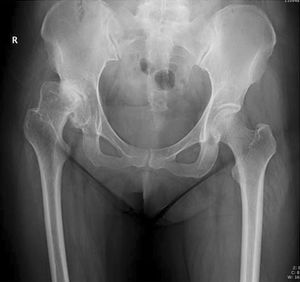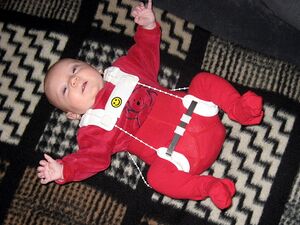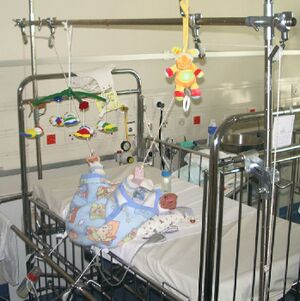Hip Dysplasia: Difference between revisions
No edit summary |
No edit summary |
||
| Line 6: | Line 6: | ||
== Introduction == | == Introduction == | ||
[[File:Hip_dysplasia_schematic.jpg|Schematic depiction of hip joint structures' positions in hip dysplasia A - Normal, B - Dysplasia, C - Subluxation, D - Luxation|alt=|299x299px|left|thumb]]'''Hip dysplasia''' refers to the abnormalities relating to size, shape, orientation or organization of either the femoral head or the acetabulum, or both.<ref>Storer SK, Skaggs DL. [https://www.aafp.org/pubs/afp/issues/2006/1015/p1310.html Developmental dysplasia of the hip]. American Family Physician. 2006 Oct 15;74(8):1310-6.</ref>It is most often the term given to infantile hip instability, shallowness of the hip socket or hip dislocation.<ref name=":6" /> | |||
'''Developmental dysplasia of the [[Hip]]''' (DDH) generally refers to hip dysplasia of the infant or child. <ref name=":6">International Hip Dysplasia Institute. Understanding Hip Dysplasia. Available from: https://hipdysplasia.org/developmental-dysplasia-of-the-hip/ (accessed 10/01/2023)</ref> . | |||
'''Acetabular dysplasia''' itself refers to an immature, shallow acetabulum. Hip dysplasia diagnosed during adolesence or adulthood is often called acetabular dysplasia because it's shallowness does not fully support the femoral head.<ref name=":6" /> | '''Acetabular dysplasia''' itself refers to an immature, shallow acetabulum. Hip dysplasia diagnosed during adolesence or adulthood is often called acetabular dysplasia because it's shallowness does not fully support the femoral head.<ref name=":6" /> | ||
Presentation varies from minor hip instability to frank dislocation. The exact etiology is still elusive. Multifactorial in nature, a combination of [[Genetic Conditions and Inheritance|genetic]], [[An Introduction to Environmental Physiotherapy|environmental]], and mechanical factors plays a role.<ref name=":3" /> | Presentation of hip dysplasia varies from minor hip instability to frank dislocation. The exact etiology is still elusive. Multifactorial in nature, a combination of [[Genetic Conditions and Inheritance|genetic]], [[An Introduction to Environmental Physiotherapy|environmental]], and mechanical factors plays a role.<ref name=":3" /> | ||
Other terms used for hip dysplasia (depending on severity and time of occurrence) include: | Other terms used for hip dysplasia (depending on severity and time of occurrence) include: | ||
| Line 19: | Line 19: | ||
* Congenital Dislocation of the hip. | * Congenital Dislocation of the hip. | ||
** It must be noted that '''Congenital Dislocation''' is not often used as this term refers to a condition present at birth which is associated with a proliferation or absence of normal tissue. In the case of DDH the hip joint is normal apart from the instability. | ** It must be noted that '''Congenital Dislocation''' is not often used as this term refers to a condition present at birth which is associated with a proliferation or absence of normal tissue. In the case of DDH the hip joint is normal apart from the instability. | ||
Early diagnosis and management of hip dysplasia will prevent long term complications e.g. persistent dislocation, limp and early hip osteoarthritis.<ref name=":3">Nandhagopal T, De Cicco FL. [https://www.ncbi.nlm.nih.gov/books/NBK563157/ Developmental Dysplasia Of The Hip]. StatPearls [Internet]. 2020 Oct 10. Available: https://www.ncbi.nlm.nih.gov/books/NBK563157/<nowiki/>(accessed 11.10.2021)</ref> | Early diagnosis and management of hip dysplasia will prevent long term complications e.g. persistent dislocation, limp and early hip osteoarthritis.<ref name=":3">Nandhagopal T, De Cicco FL. [https://www.ncbi.nlm.nih.gov/books/NBK563157/ Developmental Dysplasia Of The Hip]. StatPearls [Internet]. 2020 Oct 10. Available: https://www.ncbi.nlm.nih.gov/books/NBK563157/<nowiki/>(accessed 11.10.2021)</ref> | ||
| Line 30: | Line 24: | ||
[[Image:Hip.jpg|right|250x250px|Hip Joint|alt=|frameless]]The [[Hip Anatomy|Hip joint]] is a classical ball-and-socket joint. It meets the four characteristics of a [[Synovial Joints|synovial]] or diarthrodial joint: it has a joint cavity, joint surfaces are covered with articular cartilage, it has a [[Synovium & Synovial Fluid|synovial membrane]] producing synovial fluid, and it is surrounded by a ligamentous capsule.<ref>Byrd J. Gross anatomy. In: Byrd J, editor. Operative Hip Arthroscopy. 2nd ed. New York: Springer Science + Business Media, Inc; 2004.</ref> | [[Image:Hip.jpg|right|250x250px|Hip Joint|alt=|frameless]]The [[Hip Anatomy|Hip joint]] is a classical ball-and-socket joint. It meets the four characteristics of a [[Synovial Joints|synovial]] or diarthrodial joint: it has a joint cavity, joint surfaces are covered with articular cartilage, it has a [[Synovium & Synovial Fluid|synovial membrane]] producing synovial fluid, and it is surrounded by a ligamentous capsule.<ref>Byrd J. Gross anatomy. In: Byrd J, editor. Operative Hip Arthroscopy. 2nd ed. New York: Springer Science + Business Media, Inc; 2004.</ref> | ||
# [[Acetabulum Fracture|Acetabulum]] and femoral head development are intimately related. Development of the acetabular cavity is determined by the presence of a concentrically reduced femoral head. When the femoral head is not in contact with the acetabulum, the latter does not develop adequately and it is flat-shaped<ref name=":5" />. | # [[Acetabulum Fracture|Acetabulum]] and femoral head development are intimately related. Development of the acetabular cavity is determined by the presence of a concentrically reduced femoral head. When the femoral head is not in contact with the acetabulum, the latter does not develop adequately and it is flat-shaped<ref name=":5">Vaquero-Picado A, González-Morán G, Garay EG, Moraleda L. Developmental dysplasia of the hip: update of management. EFORT open reviews. 2019 Sep;4(9):548-56. Available: https://www.ncbi.nlm.nih.gov/pmc/articles/PMC6771078/ (accessed 12.10.2021)</ref>. | ||
# A deep concentric position of the femoral head in the acetabulum is necessary for a normal development of the hip. When the [[bone]] structures of the hip are fully grown, we can speak of a ball and socket joint between the rounded head of the [[femur]] and the cup-like acetabulum of the femur.<ref name="p1">American Academy of Pediatrics, Committee on Quality Improvement, Subcommittee on Developmental Dysplasia of the Hip, Clinical Practice Guideline : Early detection of developmental Dysplasia of the hip, Official Journal of the American Academy of Pediatrics Vol 105 No 4 April 2000, downloaded from pediatrics.applications.org at Swets Blackwell 30680247 on November 23, 2011. Level of evidence: 1 A</ref> | # A deep concentric position of the femoral head in the acetabulum is necessary for a normal development of the hip. When the [[bone]] structures of the hip are fully grown, we can speak of a ball and socket joint between the rounded head of the [[femur]] and the cup-like acetabulum of the femur.<ref name="p1">American Academy of Pediatrics, Committee on Quality Improvement, Subcommittee on Developmental Dysplasia of the Hip, Clinical Practice Guideline : Early detection of developmental Dysplasia of the hip, Official Journal of the American Academy of Pediatrics Vol 105 No 4 April 2000, downloaded from pediatrics.applications.org at Swets Blackwell 30680247 on November 23, 2011. Level of evidence: 1 A</ref> | ||
# The proximal femur is completely cartilaginous at birth<ref name=":5" />. | # The proximal femur is completely cartilaginous at birth<ref name=":5" />. | ||
== Pathology == | == Pathology == | ||
[[File:Hip displasia adult.jpg| | [[File:Hip displasia adult.jpg|alt=|thumb|Hip dysplasia in an adult]] | ||
The formation of the hip joint is highly dependent on the dynamic relationship between [[femur]] and acetabulum. Any interference with proper contact between these two in utero or infancy leads to DDH. | The formation of the hip joint is highly dependent on the dynamic relationship between [[femur]] and acetabulum. Any interference with proper contact between these two in utero or infancy leads to DDH. | ||
Maligned contact for a prolonged period leads to chronic changes like hypertrophy of capsule, ligament teres, the formation of thickened acetabular edge (neolimbus), which further prevents the contact, and prevents the relocation of the femoral head<ref name=":3" />. The very cellular hyaline [[cartilage]] allows the femoral head to glide out of the acetabulum generating the palpable clunk known as the [[Barlow and Ortolani Tests|Ortolani]] sign.<ref name=":4" /> | Maligned contact for a prolonged period leads to chronic changes like hypertrophy of capsule, ligament teres, the formation of thickened acetabular edge (neolimbus), which further prevents the contact, and prevents the relocation of the femoral head<ref name=":3" />. The very cellular hyaline [[cartilage]] allows the femoral head to glide out of the acetabulum generating the palpable clunk known as the [[Barlow and Ortolani Tests|Ortolani]] sign.<ref name=":4" /> | ||
DDH alters hip biomechanics, overloading the articular cartilage and leading to early osteoarthritis. DDH is the main cause of [[Total Hip Replacement|total hip replacement]] in young people (about 21% to 29%)<ref name=":5" />. | |||
== Epidemiology == | == Epidemiology == | ||
[[File:Neonate.jpeg|right|frameless]] | [[File:Neonate.jpeg|right|frameless]] | ||
| Line 67: | Line 61: | ||
All newborns are to be screened by physical examination. This examination includes an Ortolani or Barlow test. | All newborns are to be screened by physical examination. This examination includes an Ortolani or Barlow test. | ||
Other signs of hip dysplasia are:<ref name=":6" /> | |||
* Asymmetric gluteus folds | |||
* Asymmetrical skin folds on the legs | |||
* Apparent [[Leg Length Discrepancy|limb-length inequality]]. | |||
If Ortolani and Barlow tests are positive, ultrasonography is recommended. Ultrasound is the modality of choice in children under the age of 6 months as it is during this time the femoral head is predominantly cartilaginous and therefore cannot be picked up on X-ray. Once there is a significant ossification has occurred (over 6 months of age) then an x-ray examination can be performed.<ref>Bowen JR, Kotzias-Neto A. [https://hipdysplasia.org/wp-content/uploads/2020/07/Full-Book_Developmental-Dysplasia-of-the-Hip_Optimized.pdf Developmental dysplasia of the hip]. Data Trace Pub.; 2006.</ref> | |||
{{#ev:youtube|mv_kLqZSGdo|250}}<ref>Dr. Anisuddin Bhatti. Ortolani's Click & Barlow's Maneuver. Available from: http://www.youtube.com/watch?v=mv_kLqZSGdo [last accessed 04/05/13]</ref> | |||
== Treatment/Management == | == Treatment/Management == | ||
| Line 120: | Line 121: | ||
* Weight loss: For those overweight can significantly reduce the stress on the hip and reduce pain. | * Weight loss: For those overweight can significantly reduce the stress on the hip and reduce pain. | ||
* [[Hippotherapy]]: A specialized therapy treatment strategy that uses a horse's movement to influence the patient/client in a various number of ways.<ref>Debuse D, Chandler C, Gibb C. An exploration of German and British physiotherapists' views on the effects of hippotherapy and their measurement. Physiotherapy theory and practice. 2005 Jan 1;21(4):219-42.</ref> During hippotherapy, functional riding skills are not taught; the client sits on the horseback and physically accommodates to the three-dimensional movements of the horse's walk. Hippotherapy is shown to motivate the child to engage in therapy, maintain the child's willingness to participate and provide a playful environment while facilitating pain free movement.<ref>Roy Aldridge PT, Farley Schweighart SP, Megan Easley SP. The effects of hippotherapy on motor performance and function in an individual with bilateral developmental dysplasia of the Hip (DDH). J Phys Ther. 2011; 2:54-63</ref> | * [[Hippotherapy]]: A specialized therapy treatment strategy that uses a horse's movement to influence the patient/client in a various number of ways.<ref>Debuse D, Chandler C, Gibb C. An exploration of German and British physiotherapists' views on the effects of hippotherapy and their measurement. Physiotherapy theory and practice. 2005 Jan 1;21(4):219-42.</ref> During hippotherapy, functional riding skills are not taught; the client sits on the horseback and physically accommodates to the three-dimensional movements of the horse's walk. Hippotherapy is shown to motivate the child to engage in therapy, maintain the child's willingness to participate and provide a playful environment while facilitating pain free movement.<ref>Roy Aldridge PT, Farley Schweighart SP, Megan Easley SP. The effects of hippotherapy on motor performance and function in an individual with bilateral developmental dysplasia of the Hip (DDH). J Phys Ther. 2011; 2:54-63</ref> | ||
== Helpful resources == | |||
[https://hipdysplasia.org/developmental-dysplasia-of-the-hip/ The International Hip Dysplasia Institute] - A site with information for caregivers and health care professionals. | |||
== References == | == References == | ||
Revision as of 22:07, 13 January 2023
Original Editors - Daan Vandebriel, Ruben Van Laere
Top Contributors - Samuel Adedigba, Lucinda hampton, Kim Jackson, Lauren Heydenrych, Vidya Acharya, Laura Ritchie, Sai Kripa, Admin, Ruben Van Laere, WikiSysop, Ewa Jaraczewska, Oyemi Sillo, Rucha Gadgil and 127.0.0.1
Introduction[edit | edit source]
Hip dysplasia refers to the abnormalities relating to size, shape, orientation or organization of either the femoral head or the acetabulum, or both.[1]It is most often the term given to infantile hip instability, shallowness of the hip socket or hip dislocation.[2]
Developmental dysplasia of the Hip (DDH) generally refers to hip dysplasia of the infant or child. [2] .
Acetabular dysplasia itself refers to an immature, shallow acetabulum. Hip dysplasia diagnosed during adolesence or adulthood is often called acetabular dysplasia because it's shallowness does not fully support the femoral head.[2]
Presentation of hip dysplasia varies from minor hip instability to frank dislocation. The exact etiology is still elusive. Multifactorial in nature, a combination of genetic, environmental, and mechanical factors plays a role.[3]
Other terms used for hip dysplasia (depending on severity and time of occurrence) include:
- Developmental Dislocation of the Hip
- Hip Dislocation
- Congenital Dislocation of the hip.
- It must be noted that Congenital Dislocation is not often used as this term refers to a condition present at birth which is associated with a proliferation or absence of normal tissue. In the case of DDH the hip joint is normal apart from the instability.
Early diagnosis and management of hip dysplasia will prevent long term complications e.g. persistent dislocation, limp and early hip osteoarthritis.[3]
Clinically Relevant Anatomy[edit | edit source]
The Hip joint is a classical ball-and-socket joint. It meets the four characteristics of a synovial or diarthrodial joint: it has a joint cavity, joint surfaces are covered with articular cartilage, it has a synovial membrane producing synovial fluid, and it is surrounded by a ligamentous capsule.[4]
- Acetabulum and femoral head development are intimately related. Development of the acetabular cavity is determined by the presence of a concentrically reduced femoral head. When the femoral head is not in contact with the acetabulum, the latter does not develop adequately and it is flat-shaped[5].
- A deep concentric position of the femoral head in the acetabulum is necessary for a normal development of the hip. When the bone structures of the hip are fully grown, we can speak of a ball and socket joint between the rounded head of the femur and the cup-like acetabulum of the femur.[6]
- The proximal femur is completely cartilaginous at birth[5].
Pathology[edit | edit source]
The formation of the hip joint is highly dependent on the dynamic relationship between femur and acetabulum. Any interference with proper contact between these two in utero or infancy leads to DDH.
Maligned contact for a prolonged period leads to chronic changes like hypertrophy of capsule, ligament teres, the formation of thickened acetabular edge (neolimbus), which further prevents the contact, and prevents the relocation of the femoral head[3]. The very cellular hyaline cartilage allows the femoral head to glide out of the acetabulum generating the palpable clunk known as the Ortolani sign.[7]
DDH alters hip biomechanics, overloading the articular cartilage and leading to early osteoarthritis. DDH is the main cause of total hip replacement in young people (about 21% to 29%)[5].
Epidemiology[edit | edit source]
The reported incidence of developmental dysplasia of the hip varies between 1.5 and 20 per 1000 births, with the majority (60-80%) of abnormal hips resolving spontaneously within 2-8 weeks (so-called immature hip).
The incidence varies from 0.06 in Africans to 76.1 per 1000 in Native Americans due to the combination of genetics and swaddling.[7]
Etiology[edit | edit source]
The following are the risk factors for DDH:
- Female gender (M: F ratio ~1:8) The increased incidence is probably due to ligamentous laxity from maternal hormones.[3]
- Firstborn baby. The incidence of DDH is 10 times more in new borns with breech malposition
- Family history. eg Certain ethnic populations (Native Americans and Sami people). Some studies suggest it is linked with the hormone relaxine and /or it has something to do with chromosone 13
- Breech presentation. The legs of the foetus are pressed inside the uterus leading to hip dislocation if the ligaments are lax. The caput femoris tends to be pushed out of the acetabulum.
- Any physical limitation (eg oligohydramnios, twins) in utero can contribute to DDH. It also increases the risk of other abnormalities like Metatarsus adducts, congenital muscular torticollis, and congenital knee dislocation.
- Spina bifida[7]
- Swaddling in the adducted and extended position. Explains the increased incidence in specific populations including American Indians, Japanese and Turkish infants[3].
- Structural abnormalities eg shallow acetabulum, a flat or irregular caput femoris, a femoral or acetabular anteversion, and a decreased head offset or perpendicular distance from the center of the femoral head to the axis of the femoral shaft.[8][9][10]
Characteristics/ Clinical presentation[edit | edit source]
Clinical features vary for mild hip instability, limited abduction in the infant, less mobility or flexibility on one side, limping or toe walking, and osteoarthritis in the adult.[3]
Developmental dysplasia of the hip is usually suspected in the early neonatal period due to the widespread adoption of clinical examination (including the Ortolani test, Barlow manoeuvres, and Galeazzi sign).[7]
Diagnostic procedures[edit | edit source]
All newborns are to be screened by physical examination. This examination includes an Ortolani or Barlow test.
Other signs of hip dysplasia are:[2]
- Asymmetric gluteus folds
- Asymmetrical skin folds on the legs
- Apparent limb-length inequality.
If Ortolani and Barlow tests are positive, ultrasonography is recommended. Ultrasound is the modality of choice in children under the age of 6 months as it is during this time the femoral head is predominantly cartilaginous and therefore cannot be picked up on X-ray. Once there is a significant ossification has occurred (over 6 months of age) then an x-ray examination can be performed.[11]
Treatment/Management[edit | edit source]
The goal is to provide an optimal environment for the growth of the femoral head and acetabulum. So a high index of suspicion and routine surveillance is needed to detect DDH and prevent complications.
All treatment efforts are based on obtaining a concentrically positioned femoral head into the acetabulum so the latter is stimulated to grow normally. Acetabular potential of correction diminishes dramatically after three to four years of age; therefore, early interventions are paramount to obtain the best results with less surgical aggression[5]. Various treatment modalities like abduction splinting, closed reduction, open reduction are available.
Double diapering is most likely harmless, but efficacy is close to zero.[3]
The treatment depends on the age of the patient and the degree of dysplasia.
- Minor hip instability (Barlow positive, Ortalani negative) spontaneously recovers in 90% of cases in the first two weeks of life.
- Continued surveillance by the primary care provider during infancy improves detection and early referral.
- Pavlik harness corrects 95% of DDH if applied before six months.
- Residual dysplasia occurs even after appropriate treatment, so annual follow up is required until skeletal maturity.
- Without early treatment, the child may develop limp, leg length discrepancy, limited hip abduction, and in fact, DDH is the most common cause of early osteoarthritis in women under age 40.[3]
The higher the age at presentation, the worse the outcomes after intervention for DDH. By the age of eight years, it is thought that possible complications of treatment may lead to a poor outcome, no better than if DDH is left untreated[5]
This is a video (3 minutes) re DHD from the mothers view of her neonatal girl.
Physiotherapy for DHD in Babies[edit | edit source]
Even though DHD is common and usually very well managed, it can be hard and overwhelming for new parents to deal with the dos and don’ts along with the other struggles of parenthood. With physiotherapy we can help the parents feel empowered and enable them to help their babies along the process of healing.
Although it is not standard practice for a paediatrician to refer to a physiotherapist but a visit to a physiotherapist after the diagnosis gives parents a better insight and can help with managing the condition at home specifically during the splint free time at home.
Research has shown that appropriate massage, stretching and strengthening can help with the recovery of the hip while the child is in the brace. All these treatments can be performed by the parents at home once perfected by a visit to the physiotherapist every month.
A baby can exercise and strengthen the hip muscles by using their developmental milestones to their advantage. A physiotherapist should do a thorough assessment of the baby, go through the scans, follow the recommendations by the paediatrician and make a plan that suits the baby according to their age[14].
eg a baby with hip dysplasia needs to be kept in a certain position to give their hip a mechanical advantage. So if it is a baby who is 6 months old, the physiotherapist takes advantage of their current milestones and trains the hip muscles on a number of surfaces keeping the hip position in mind and challenge the hip muscles. This also avoids the chances of delayed milestones that can happen in babies with serial and prolonged periods of casting.
Image 4: Baby wearing a Pavlik harness
When the child is younger than 6 month the use of a special brace called a Pavlik harness is used.[15] The brace holds the hips of the baby in the correct position. Over time the joint begins normal formation. About 90% of the newborns treated with the Pavlik harness will recover fully. Also a Frejka Pillow is used but is not indicated in all forms of hip dysplasia.
When the child is older then 6 months the Pavlik harness may not be successful. In that case a surgeon will place the hip in the proper position under anesthesia. Once in this position the child will be placed in a spica cast. The spica cast is similar to the Pavlik harness but allows less movement.
Image 5: Traction A form of treatment for Hip dysplasia
A treatment that isn’t often used is traction. Traction exists of the application of a force to stretch certain parts of the body in a certain direction. This will soften the tissue around the caput femoris and will allow the caput femoris to move back in the acetabulum. Traction consists of pulleys, strings, weights, and a metal frame attached over or on the bed. Traction is most often used for approximately 10 to 14 days. The application of ice on the painful regions helps to numb pain and reduces the inflammation.[16]
Physiotherapy for older child/adult DHD[edit | edit source]
Therapy is important to correct poor posture, muscle weakness, poor joint awareness, and associated tendon inflammation. Therapy can improve all these factors including the strength of hip extensors and external rotators, gait re-education, and improving body awareness. Strong muscles will act like shock absorbers and provide greater support for the hip.
If osteoarthritis of the hip is present see this connection for Physiotherapy
- Exercise: Regular, low- or non-impact exercise such as swimming, aquatic therapy or cycling train strength and range of motion.
- Weight loss: For those overweight can significantly reduce the stress on the hip and reduce pain.
- Hippotherapy: A specialized therapy treatment strategy that uses a horse's movement to influence the patient/client in a various number of ways.[17] During hippotherapy, functional riding skills are not taught; the client sits on the horseback and physically accommodates to the three-dimensional movements of the horse's walk. Hippotherapy is shown to motivate the child to engage in therapy, maintain the child's willingness to participate and provide a playful environment while facilitating pain free movement.[18]
Helpful resources[edit | edit source]
The International Hip Dysplasia Institute - A site with information for caregivers and health care professionals.
References[edit | edit source]
- ↑ Storer SK, Skaggs DL. Developmental dysplasia of the hip. American Family Physician. 2006 Oct 15;74(8):1310-6.
- ↑ 2.0 2.1 2.2 2.3 International Hip Dysplasia Institute. Understanding Hip Dysplasia. Available from: https://hipdysplasia.org/developmental-dysplasia-of-the-hip/ (accessed 10/01/2023)
- ↑ 3.0 3.1 3.2 3.3 3.4 3.5 3.6 3.7 Nandhagopal T, De Cicco FL. Developmental Dysplasia Of The Hip. StatPearls [Internet]. 2020 Oct 10. Available: https://www.ncbi.nlm.nih.gov/books/NBK563157/(accessed 11.10.2021)
- ↑ Byrd J. Gross anatomy. In: Byrd J, editor. Operative Hip Arthroscopy. 2nd ed. New York: Springer Science + Business Media, Inc; 2004.
- ↑ 5.0 5.1 5.2 5.3 5.4 Vaquero-Picado A, González-Morán G, Garay EG, Moraleda L. Developmental dysplasia of the hip: update of management. EFORT open reviews. 2019 Sep;4(9):548-56. Available: https://www.ncbi.nlm.nih.gov/pmc/articles/PMC6771078/ (accessed 12.10.2021)
- ↑ American Academy of Pediatrics, Committee on Quality Improvement, Subcommittee on Developmental Dysplasia of the Hip, Clinical Practice Guideline : Early detection of developmental Dysplasia of the hip, Official Journal of the American Academy of Pediatrics Vol 105 No 4 April 2000, downloaded from pediatrics.applications.org at Swets Blackwell 30680247 on November 23, 2011. Level of evidence: 1 A
- ↑ 7.0 7.1 7.2 7.3 Radiopedia Developmental dysplasia of the hip Available: https://radiopaedia.org/articles/developmental-dysplasia-of-the-hip (accessed 11.10.2021)
- ↑ John Crawford Adams, David L. Hamblem, Outline of Orthopaedics, Churcill Livingstone, 1995, twelfth edition, p. 292 – 301.
- ↑ John Crawford Adams, David L. Hamblem, Outline of Orthopaedics, Churcill Livingstone, 2001, thirteenth edition, p. 305 – 312.
- ↑ J.Maheshwari. Essential Orthopaedics. 6th edition. Jaypee Brothers Medical Publishers,2019
- ↑ Bowen JR, Kotzias-Neto A. Developmental dysplasia of the hip. Data Trace Pub.; 2006.
- ↑ Dr. Anisuddin Bhatti. Ortolani's Click & Barlow's Maneuver. Available from: http://www.youtube.com/watch?v=mv_kLqZSGdo [last accessed 04/05/13]
- ↑ Childrens Hospital. Angela and hip dysplasia - Boston Children's Hospital. Available from: http://www.youtube.com/watch?v=bShtxYFdERQ [last accessed 04/05/13]
- ↑ Inner Strength Physiotherapy for hip dysplasia in babies: a way to empower parents to help their little humans. Available: https://www.innerstrengthbayside.com.au/physiotherapy-for-hip-dysplasia-in-babies-a-way-to-empower-parents-to-help-their-little-humans/(accessed 12.11.2021)
- ↑ Guille JT, Pizzutillo PD, MacEwen GD. Developmental dysplasia of the hip from birth to six months. JAAOS-Journal of the American Academy of Orthopaedic Surgeons. 2000 Jul 1;8(4):232-42.
- ↑ Enseki KR, Martin RL, Draovitch P, Kelly BT, Philippon MJ, Schenker ML. The hip joint: arthroscopic procedures and postoperative rehabilitation. Journal of Orthopaedic & Sports Physical Therapy. 2006 Jul;36(7):516-25.
- ↑ Debuse D, Chandler C, Gibb C. An exploration of German and British physiotherapists' views on the effects of hippotherapy and their measurement. Physiotherapy theory and practice. 2005 Jan 1;21(4):219-42.
- ↑ Roy Aldridge PT, Farley Schweighart SP, Megan Easley SP. The effects of hippotherapy on motor performance and function in an individual with bilateral developmental dysplasia of the Hip (DDH). J Phys Ther. 2011; 2:54-63













